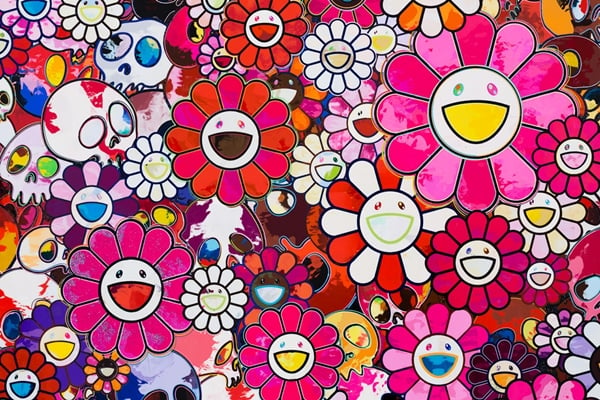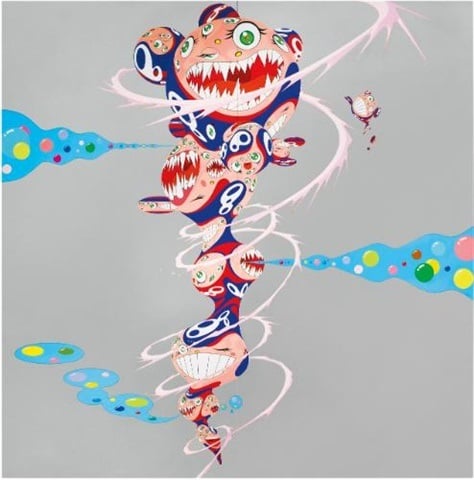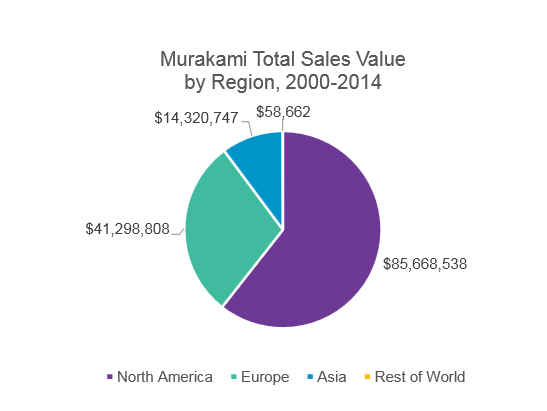Galleries
Art Market Analysis: Why Collectors Love Takashi Murakami, Part One
The artist's market is not just holding value but growing.

The artist's market is not just holding value but growing.

Eileen Kinsella &
Jonathan Yee

Japanese artist Takashi Murakami is considered one of the most influential contemporary artists to emerge from Asia in recent decades and has a thriving international market to match. With “In the Land of the Dead, Stepping on the Tail of the Rainbow,” a solo show opening at Gagosian in Chelsea on November 10 and several works on offer during the contemporary art day sales next week, it seems like a good time to take a look at his market.
Murakami’s wide ranging and prolific practice, which has drawn comparisons to Warhol for his large studios in New York and Tokyo and his teams of assistants, encompasses everything from paintings, sculpture, and installations to merchandise for high-end luxury brands like Louis Vuitton. He’s become best known for his whimsical Japanese-anime inspired characters, notably Mr. DOB, a sharp-toothed, yet playful comic character whose name is a contraction of the Japanese slang expression “dobojite” or “why?”

Source: artnet Market Watch
The DOB series of paintings has performed consistently at auction, outpacing the S&P 500 since 2007, artnet data shows (above).
Further boosting the artist’s global fame and robust market, in 2007, a comprehensive traveling survey show “© MURAKAMI” opened at the Museum of Contemporary Art, Los Angeles before moving on to the Brooklyn Museum, Museum für Moderne Kunst, Frankfurt, and the Guggenheim Museum, Bilbao.

The record at auction for Murakami was the $4.4 million paid for Castle of Tin-Tin (1998) at Sotheby’s New York in November 2012.
While Murakami’s major works can fetch millions at auction, including the current record of $4.4 million for The Castle of Tin Tin (1998), which was sold at Sotheby’s New York in November 2012, Christie’s and Sotheby’s are each featuring lower-priced Murakami works in their upcoming contemporary day sales, ranging from his acrylic on panel Mushroom (2002) with an estimate of $25–35,000 at Sotheby’s on November 21 to Monogramouflage Treillis (2008), an acrylic on canvas mounted on aluminum frame, with an estimate of $250–350,000 at Christie’s on November 13.

Source: artnet Market Watch
Data from artnet Market Watch tracking Murakami auction sales between 2000 and 2014 indicates that the bulk of the sales ($85 million), were made at auctions in North America, followed by Europe ($41.3 million) and Asia. New York leads in overall sales volume, followed by London and then Hong Kong as far as auction prices are concerned.
But experts say this is beginning to change. “What you saw in 2007 and 2008 was that this was mainly a western market,” says Miety Heiden, Sotheby’s head of contemporary private sales, North America. “What we see now is better and better prices in Hong Kong,” as Asian buyers become more active. Case in point is a Murakami diptych The World of Sphere that garnered $2.5 million at Sotheby’s Hong Kong last November, becoming the second highest price at auction after Tin-Tin.
At a special-themed Sotheby’s sale held earlier this month, entitled “Nigo Only Lives Twice,” which featured 250 lots from the Japanese designer and music producer’s collection, collaborative pieces by Murakami and Marc Jacobs were a hot item. A group of items including a limited edition “Eye Dare You” overnight bag, jewelry boxes, and a bi-fold wallet and key chain, which together carried an estimate of $84-$1,110 soared to just under $21,000 (HK$162,500).
Next up, in part two of our report, we compare Murakami’s auction performance with contemporaries like Yoshitomo Nara and heavyweights Damien Hirst and Jeff Koons.